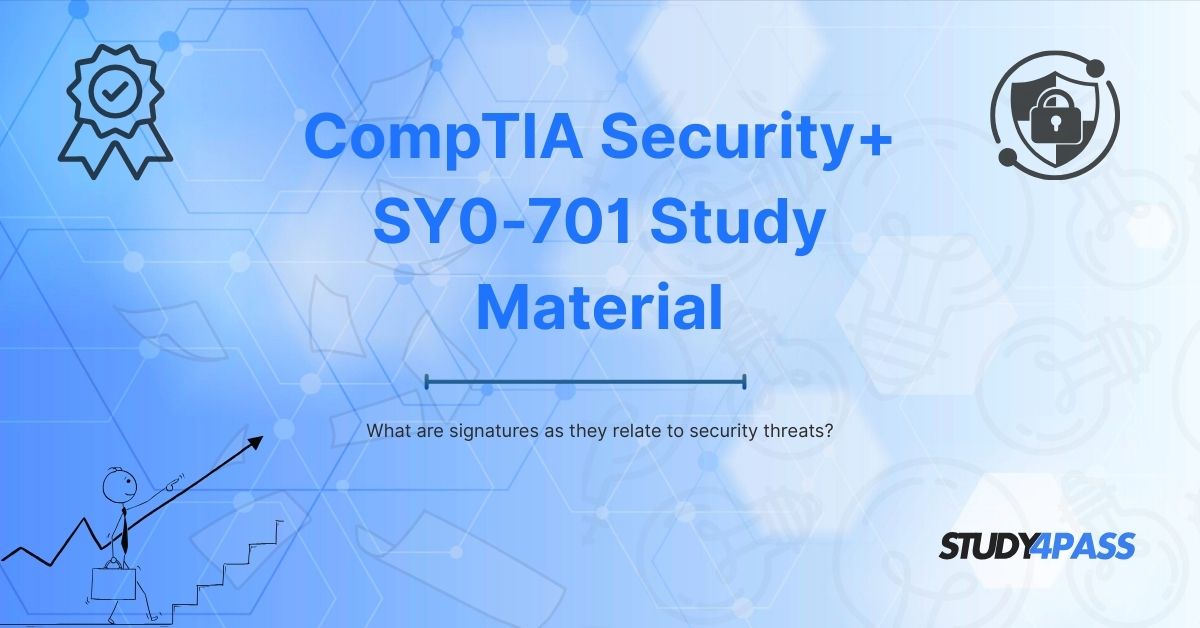Introduction
In the realm of cybersecurity, signatures play a crucial role in identifying and mitigating security threats. For professionals preparing for the CompTIA Security+ (SY0-701) exam, understanding signatures is essential for mastering threat detection and response. This article explores what signatures are, their role in security threats, and how they are applied in cybersecurity defenses. Additionally, we will highlight Study4Pass, a premier resource for SY0-701 study material, offering high-quality exam preparation tools to help you succeed.
What Are Signatures in Cybersecurity?
A signature in cybersecurity refers to a unique identifier or pattern associated with a specific threat, such as malware, viruses, or intrusion attempts. Security systems use signatures to detect and block malicious activities by comparing observed behaviours or files against a database of known threats.
Types of Signatures
- Malware Signatures – Unique code snippets or file hashes that identify viruses, worms, trojans, and ransomware.
- Network Intrusion Signatures – Patterns in network traffic that indicate attacks like DDoS, SQL injection, or port scanning.
- Behavioural Signatures – Abnormal system behaviours (e.g., rapid file encryption) that suggest malicious activity.
- File-Based Signatures – Digital fingerprints (MD5, SHA-1 hashes) used to detect malicious files.
How Signatures Help in Threat Detection?
Signature-based detection is a foundational method in cybersecurity. Here’s how it works:
1. Antivirus & Anti-Malware Systems
- Scans files and processes against a signature database.
- Blocks or quarantines detected threats.
2. Intrusion Detection & Prevention Systems (IDS/IPS)
- Monitors network traffic for attack signatures.
- Alerts administrators or blocks malicious traffic automatically.
3. Email & Web Security Gateways
- Filters phishing emails, malicious attachments, and harmful URLs using signature analysis.
4. Endpoint Detection & Response (EDR)
- Uses behavioural signatures to detect advanced threats like file less malware.
Limitations of Signature-Based Detection
While effective, signature-based detection has weaknesses:
- Zero-Day Threats – Cannot detect previously unknown attacks without existing signatures.
- Polymorphic Malware – Malware that changes its signature to evade detection.
- High False Positives/Negatives – May misidentify legitimate files as threats or miss sophisticated attacks.
To overcome these limitations, modern security systems combine signature-based detection with:
- Heuristic Analysis (behavior-based detection)
- Machine Learning & AI (anomaly detection)
- Threat Intelligence Feeds (real-time updates)
Signatures in CompTIA Security+ (SY0-701) Exam
The SY0-701 exam tests candidates on various security concepts, including:
Key Topics Related to Signatures:
- Threat Detection Techniques – Understanding signature-based vs. anomaly-based detection.
- Security Tools – How IDS/IPS, SIEM, and antivirus software use signatures.
- Vulnerability Management – Patching systems to defend against known threats.
- Incident Response – Using signatures to identify breach sources.
To excel in the exam, you need structured study materials that explain these concepts clearly—Study4Pass provides exactly that.
Why Choose Study4Pass for SY0-701 Exam Preparation?
Study4Pass is a trusted platform for CompTIA Security+ SY0-701 preparation, offering:
1. Comprehensive Study Guides
- Detailed explanations of security concepts, including signatures, threat detection, and mitigation strategies.
2. Practice Exams & Quizzes
- Simulates real exam scenarios to test your knowledge.
- Helps identify weak areas for improvement.
3. Up-to-Date Content
- Aligns with the latest SY0-701 exam objectives.
- Covers emerging threats and defense mechanisms.
4. Interactive Learning Tools
- Flashcards, video tutorials, and hands-on labs for better retention.
5. Expert Support
- Access to cybersecurity professionals for doubt resolution.
By using Study4Pass, you gain a competitive edge in passing the CompTIA Security+ exam on your first attempt.
Conclusion
Signatures are a fundamental aspect of cybersecurity, enabling systems to detect and block known threats efficiently. For CompTIA Security+ (SY0-701) candidates, mastering signature-based detection is crucial for understanding broader security mechanisms.
However, since cyber threats constantly evolve, relying solely on signatures is insufficient. Modern security requires a blend of signature-based, behavioral, and AI-driven techniques.
To ensure success in your SY0-701 exam, leverage high-quality study resources from Study4Pass, which provides comprehensive, exam-focused materials to help you achieve certification with confidence.
Start your journey today with Study4Pass and secure your future in cybersecurity!
Final Words
Understanding signatures and their role in security threats is just one piece of the CompTIA Security+ SY0-701 puzzle. With the right preparation, you can master all exam objectives and become a certified cybersecurity professional.
Special Discount: Offer Valid For Limited Time “SY0-701 Exam Prep Practice Test”
Actual Exam Questions For CompTIA's SY0-701 Certification
Sample Questions For CompTIA SY0-701 Exam Prep Practice Tests
1. What is a "signature" in the context of cybersecurity threats?
a) A handwritten autograph used for authentication
b) A unique identifier or pattern used to detect malware or attacks
c) A digital certificate used for encryption
d) A password policy for secure logins
2. How do security systems use signatures to protect against threats?
a) By comparing network traffic or files against a database of known malicious patterns
b) By requiring users to sign documents before accessing systems
c) By encrypting all data with a unique signature key
d) By blocking all unsigned software from running
3. Which of the following is a limitation of signature-based threat detection?
a) It cannot detect previously unknown (zero-day) threats
b) It requires frequent manual updates from users
c) It slows down internet speed significantly
d) It only works on Windows operating systems
4. What type of security tool primarily relies on signatures to identify threats?
a) Firewall
b) Antivirus software
c) VPN (Virtual Private Network)
d) Two-factor authentication (2FA)
5. Why must signature databases be regularly updated in cybersecurity?
a) To ensure compliance with legal regulations
b) To detect new and evolving malware strains
c) To increase the storage capacity of security tools
d) To reduce the number of false positives in detection


